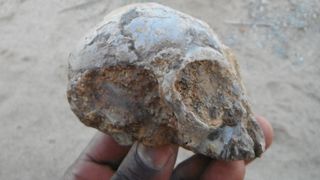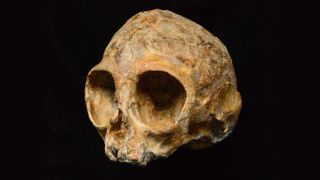In Photos: 13-Million-Year-Old Primate Skull Discovered
Napudet site

A 13-million-year-old skull of an extinct ape was discovered at a site called Napudet (shown here), west of Lake Turkana in Kenya in 2014. Now, the primate skull is revealing what the last common ancestor of all living apes and humans may have looked like. Apperently, this primate dubbed "Alesi" would have resembled a baby gibbon. [Read the full story on Alesi]
Alesi - 2

The field crew of the Turkana Basin Institute is shown here when Alesi was discovered at Napudet in September 2014. From Left to right: Abdala Ekuon, John Ekusi, Isaiah Nengo, Bernard Ewoi, Akai Ekes, and Cyprian Nyete.
Alesi - 3

Cyprian Nyete (left) and Isaiah Nengo (right) excavate Alesi, using fine picks and brushes, as well as a hardener to protect the fossil bone.
Alesi - 4

Alesi is shown partially excavated after careful removal of loose sand and rocks with dental picks and brushes. The primate would have been just 16 months old when it died.
Alesi - 5

Akai Ekes and John Ekusi watch as Isaiah Nengo lifts the sandstone block with Alesi, after six hours of excavation.

Alesi's lemon-size skull, shown after attached sandstone rock was partially removed, still had the roots of baby teeth.
Alesi - 7

From Alesi's teeth, the researchers concluded that the primate would have been a fruit eater. The researchers couldn't tell if Alesi was male or female, since the primate was too young for sex-related skull features to have formed, the researchers said.
Sign up for the Live Science daily newsletter now
Get the world’s most fascinating discoveries delivered straight to your inbox.
Alesi - 8

As an adult, the primate would have weighed about 24.9 lbs. (11.3 kilograms), with a brain about as big as that of a modern lemur of the same size, the researchers said.
Alesi - 9

The researchers scanned Alesi with a high-resolution X-ray setup at the European Synchrotron Radiation facility. The skull was mounted on a rotating platform in front of the detector, and a laser beam is used for accurate alignment.
Alesi - 10

Map of Africa and Kenya, showing the location of Napudet, where Alesi was found. [Read the full story on Alesi]

Jeanna served as editor-in-chief of Live Science. Previously, she was an assistant editor at Scholastic's Science World magazine. Jeanna has an English degree from Salisbury University, a master's degree in biogeochemistry and environmental sciences from the University of Maryland, and a graduate science journalism degree from New York University. She has worked as a biologist in Florida, where she monitored wetlands and did field surveys for endangered species. She also received an ocean sciences journalism fellowship from Woods Hole Oceanographic Institution.
Most Popular

